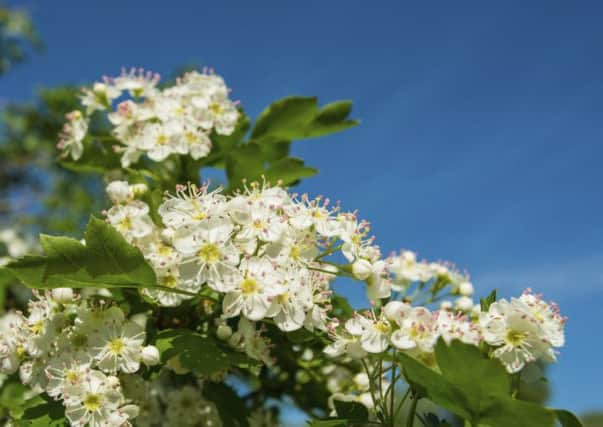Gardeners inspired to get to grips with a thorny issue


It is at this time of the year that one of the most unassuming stars of the British countryside briefly emerges from the shadows. .
Typically, hawthorn plays the part of the countryside’s unobtrusive backing singer, giving way to the gaudy attention-grabbing bluebells, daffodils and ox-eye daisies. But at some indefinable point in May, when the days get long enough and the weather heats up, the hawthorn begins to bloom.
Advertisement
Hide AdAdvertisement
Hide AdThis year’s mild winter has seen a white wall of blooms creeping across the countryside. While it was once was believed that monumental bad luck would befall anyone foolish enough to bring a few sprigs inside the home - it’s thought the plant’s dubious reputation may stem from its often overpowering bitter-sweet scent, its benefits are now widely recognised.
The huge hawthorn network has proved a vital boost to the country’s wildlife, providing a key habitat for many insects, birds and mammals.
Woodland Trust citizen science manager Kate Lewthwaite explains: “Hawthorn is a fantastic species that supports a wide variety of insects, birds and animals. Its dense, thorny foliage is perfect for nesting birds, and the flowers are a brilliant source of food for mammals such as dormice. Bees and pollinating insects will also appreciate the pollen and nectar from the flowers.”
The spread of hawthorn was aided by the Enclosure Act of 1845. When planted in rows, the tree grows into an impenetrable field boundary - just the thing needed to enclose open and rambling land. In fact, more than 200,000 miles of hawthorn, also known as the May Tree, were planted as a result of the Act.
Advertisement
Hide AdAdvertisement
Hide AdHowever, while it may be commonplace in the countryside, the charity Plantlife is encouraging gardeners to go native and plant British species like hawthorn in their gardens.
The hope is that if they can get the country’s gardeners on board it will support some of Britain’s rarest and most threatened species of wildflowers. According to latest figures, green-winged orchids have decreased by 50 per cent over the last 50 years, while lesser butterfly orchids and greater butterfly orchids have also declined by 60 per cent and 47 per cent respectively.
Wild native flowers are being lost at a rate of up to nearly one species per year per county and the rate of loss is accelerating. Today only two per cent of the flower meadows that were here in the 1930s remain. When wild flowers disappear, so does the wildlife that relies on them and Plantlife hopes that by encouraging gardeners to plant native wildflowers, the public will pay closer attention to their dramatic loss in the wider countryside.
Plantlife’s botanical specialist Dr Trevor Dines explains: “Many of our garden favourites, like Box, Pasqueflower and Welsh Poppy are also some of our rarest native plants. It always amazes me that you can pop into almost any garden centre, DIY shop or nursery in the country and by a plant of Shrubby Cinquefoil, but this same species is a beautiful native wildflower restricted to just two small areas in Britain.
Advertisement
Hide AdAdvertisement
Hide Ad“Plantlife’s Wildflower Garden aims to celebrate the native flowers we probably already grow, introduce a few new ones and discover the fascinating stories behind them as British wild flowers; did you know for example that, according to legend, Pasqueflower grows from the blood of buried Viking warriors?
“You don’t need to let your garden become overgrown and tatty to enjoy them; wild plants and flowers can be woven into the tapestry of all garden styles, from cottage to formal.”
For more information about going native in your garden visit www.plantlife.org.uk